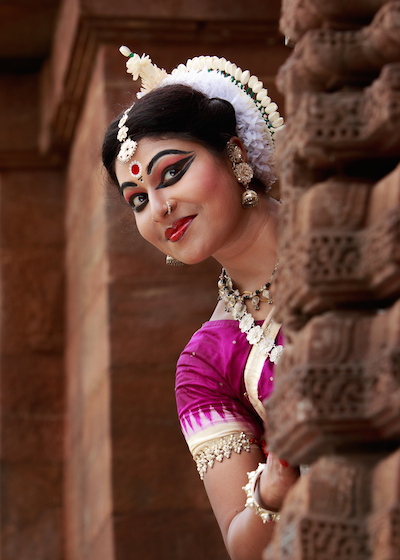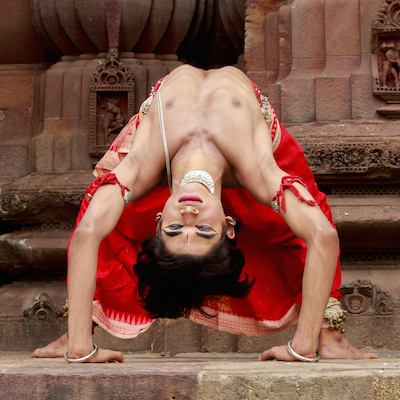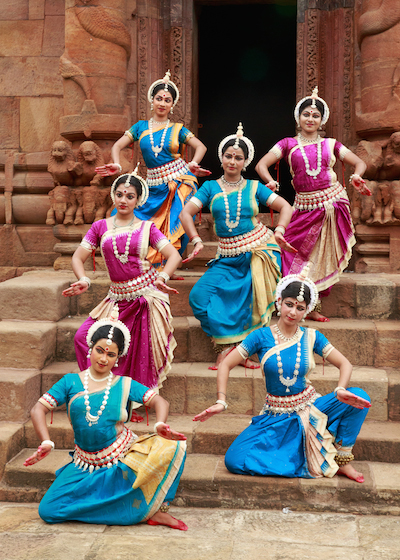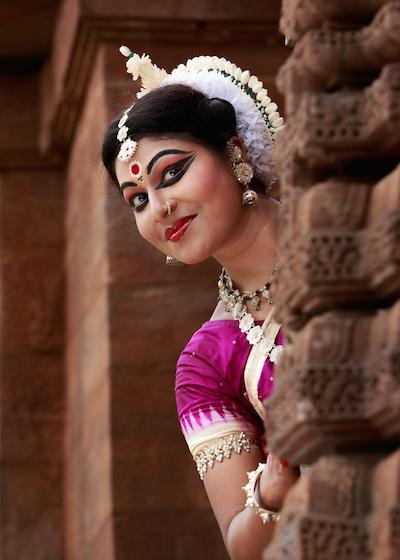The first time I saw the the Odissi dancers—who are performing at LACMA next Wednesday, June 18— is an experience I will never forget. While touring Eastern India with the Southern Asian Art Council, we asked to visit a local dance school. It was not on the itinerary but we were in Bhubaneswar the capital of Odisha and the center of the classical Odissi style. Never did we imagine what a special event we would experience. We were ushered into a simple house that served as the home for the Rudrakshya Dance Institute. There wedged into a corner with a pile of living room furniture we were inches from the artists as they practiced for a state wide competition that night. The female dancers made their entrance sensually gliding into the room in that tribhangi posture characteristic of Odissi dance that permits the head, chest and pelvis to move independently with lyrical grace. Then the male dancers leapt into their midst with lithe agility and strong footwork. The juxtaposition of the male and female forms was breathtaking. The dancers’ bodies rippled with an intense controlled power as their eyes flashed expressively. They were so close that we could see the perspiration dripping from their bodies. From an adjoining alcove the rhythms of the punkawaj (drum) and the strains of the veena (stringed instrument) wafted into the room. The energy was palpable. Overwhelmed by the music and dance, our spirits soared.
 Photo by Santanu Das
Photo by Santanu Das
When the Rudrakshya Dance Institute performs at LACMA next week, the troupe of eight male and female dancers promises to deliver the same spiritual experience in its program of Yoga in Dance. Odissi dance like yoga has the ultimate goal of moksha or spiritual liberation. Like the practice of yoga the learning of classical dance is one of intense sadhana (spiritual discipline) that demands complete physical and mental concentration. Woven into the dance repertoire will be demonstrations of hatha and raja yoga with its mastery of the physical body and intense mental focus.
 Photo by Santanu Das
Photo by Santanu Das
Odissi, one of the eight classical dance forms of India, has its beginnings in ancient times. In fact the earliest archaeological evidence for dance in India are the second century B.C. relief sculptures at Udaygiri, Odisha. There dancers accompanied by an orchestra are found performing on the walls of Rani-Gumpha Sanskrit theater. The Natyashastra, a two thousand year old treatise on the performing arts, confirms Odissi’s antiquity by mentioning the dance of Ordhra Magadha, modern-day Odisha.
Temples have always been the center for the arts. From early times in Odisha, dance was a part of worship in Buddhist, Jain, and Hindu shrines. The walls of the sacred spaces were adorned with sculptures in dance poses. When the magnificent Puri temple was erected in the 11th century to Lord Jagannatha (a form of Krishna), dance was made a part of an elaborate set of temple rituals.
 Photo by Santanu Das
Photo by Santanu Das
 Jagannatha, Subhadra, and Balabhadra Enshrined Panu Maharana (India, 20th century) India, Odisha (Orissa), Puri, 1952, gift of Walter and Nesta Spink
Jagannatha, Subhadra, and Balabhadra Enshrined Panu Maharana (India, 20th century) India, Odisha (Orissa), Puri, 1952, gift of Walter and Nesta Spink
Female dancers known as maharis (great chosen ones) were married to Lord Jagannatha, and served the god in the temple throughout their lives. Skilled in dance and music they performed stories of Krishna before Lord Jagannatha.
 Photo by Santanu Das
Photo by Santanu Das
Outside the temple precinct there was a parallel tradition of male dancers known as gotipuas (single boys). These young boys (ages 5–17) dressed as females and carried the devotional poetry beyond the temple walls since women were not allowed to perform in public at that time. Included in their dance repertoire were amazing feats of acrobatic and yogic skills. Gotipuas were known for their physical prowess so when Puri was threatened with invasion King Ramachandradeva allocated a whole street near the temple to the gotipuas. They were to be Lord Jagannath’s protectors. Ramachandradeva also built a number of gymnasiums throughout the town that acted as training centers for the young boys. They stressed both physical exercise and the art of dance.
 Photo by Santanu Das
Photo by Santanu Das
Gotipuas came to prominence in the 16th century when a popular devotional movement encouraged the worship of Krishna as a female devotee. Every devotee was seen as a consort of Krishna. Gotipuas dressed as females were well poised to be the messengers of this new movement.
The Odissi dance style started to spiral into decline in the 17th century. First the Mughals and then the British robbed the royalty of their power and money so they could no longer afford to support the local temples and be patrons of the arts. These forces hammered away at a sacred tradition that appeared unseemly to them. Dancing in the temple was seen as scandalous. They found it difficult to recognize maharis as women of god. The lack of patronage forced many dancers into prostitution. The whole system of sculptors, musicians, dancers and painters suffered. By the beginning of the 20th century little remained of the of the once great dance tradition. For the most part, gotipuas did not suffer the same fate as the maharis because they were outside the temples and not a part of an institution that was under attack from the government. This was indeed fortunate because the gotipua tradition helped to reconstruct the Odissi dance style in post independent India. Ancient texts, temple sculptures and remnants of the gotipua tradition all went into the revival of Odissi by a group of dedicated scholars and artists.
On June 18th, come to LACMA to experience the mahari lyricism coupled with the power of the gotipua tradition in Yoga in Dance.
 Shiva's Family on Mount Kailasa India, Odisha (Orissa), Vishnupur, 14th–15th century, Harry and Yvonne Lenart Fund and Museum Acquisition Fund
Shiva's Family on Mount Kailasa India, Odisha (Orissa), Vishnupur, 14th–15th century, Harry and Yvonne Lenart Fund and Museum Acquisition Fund
Kay Talwar



